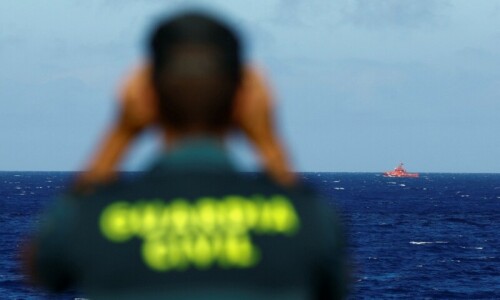
RAWALAKOT: The settlement of Rawalakot lies at an elevation of around 5,400 feet, a little lower than Murree. Drive about two hours or so from here and you suddenly reach an altitude of 8,500 to 9,000 feet: literally amidst the clouds. At this height, there is a marked drop in temperature. Travelling from Bagh, which is located in a valley, the temperature is around 34°C; at Haji Pir around 18°C.
As we stop at Lasdana for tea and point out to the locals that they are fortunate to be living in paradise, the comment nets a rather crude expletive as an answer. “It is fine if you are a tourist but if you travel up and down every day, and have little access to basic facilities, would you say the same?” the man wonders.
A few days of travel establishes the truth behind his observation. There is a palpable sense of neglect here, with little enterprise and an absence of a significant middle-class. Those that are well-off move to Rawalpindi and other large urban centres. Most stores carry substandard, mostly local, products and the eateries are primitive: where we are staying, the household meat quota is procured from Rawalpindi.
Not realising our potential seems inexorably entwined with our country’s destiny. Despite an abundance of resources, we remain unable to harness them for the betterment of the national economy. The country’s northern areas offer perfect opportunities for tourism, with unequalled beauty and pleasant climes. Of the more popular destinations, the area of Azad Jammu and Kashmir (AJK) remains relatively less frequented.
The locals advise travelling to Kashmir during May and June. The weather is perfect and the valley’s stunning panorama can be studied unhindered. We, unknowingly, have come during the monsoons. The road to Rawalakot via Rawalpindi and Kahuta is in a terrible state of disrepair, as are most roads in AJK. From Rawalpindi, the drive takes four hours or so. Earlier, people had the choice of travelling by air, but Rawalakot airport — one of the most charming and scenic in Pakistan — now lies abandoned, with the runway being used by locals for recreation and a place for tying up goats. The reason: PIA’s lack of small aircraft.
In Kashmir, the dimensions of poverty are vertical. As you move towards the heights all signs of enterprise end and purely self-sufficient, livestock-based pastoral lifestyles remain. There is little begging generally in the area but again, as you move up, there is an increase and at the more popular tourist destinations, quite common.
There is little provision of basic facilities, particularly health. Apart from the rare basic health units, in the remote areas more extensive services are provided by the army. Some of the larger towns have full-fledged hospitals but again, run by the military. Army doctors say that about 70 per cent of the patients are civilians. Even so, getting patients to these facilities is an ordeal. “In emergencies and in the case of road blockages, there is little that can be done,” we are told.
The education infrastructure is slightly better, with a significant number of schools and colleges dotting the landscape: public, private and those run by NGOs. But an imbalance has emerged: the women are more educated. This is a good thing in itself, but it is changing society. “Earlier, we used to be self-sufficient in terms of raising dairy animals,” says one man. “Now, the women complain that they can’t stand the smell!”
There are inherent constraints that contribute to the limited development in AJK. Most people live under the shadow of the Line of Control; the threat becomes more tangible at night. India turns on the lights on the fenced border sequentially: the march of illumination feels ominous, a glowing caterpillar moving along the spine of mountaintops. There are frequent ceasefire violations from the Indian side, especially these days.
Due to the mountainous terrain, there is necessarily limited space. Humans and animals vie for space on rooftops and roads. There is little terraced or other types of farmland, with the exception of small corn plantations adjoining the houses. The dead too rest amongst the living. Most houses or small groups have their own graveyards. Some of them bear testimony to majestic vistas, the perfect places to rest in eternal peace. There is an abundance of lush vegetation, which requires little effort or watering. Numerous fruit trees grow indigenously, including pears, apples (mostly small varieties), walnuts, figs (also small varieties), and many others. Yet there seems to be no concerted effort to make this commercially viable.
The abundant natural potential of the area lies ignored. A little effort expended on developing infrastructure for tourism, agriculture (fruit trees) and small- to medium-sized hydel power plants would entirely change the locals’ fortunes. If done correctly, then perhaps Kashmir would be as the Mughal emperor pointed out: if there is paradise on earth, it lies here, here!
Published in Dawn, October 13th, 2017













































